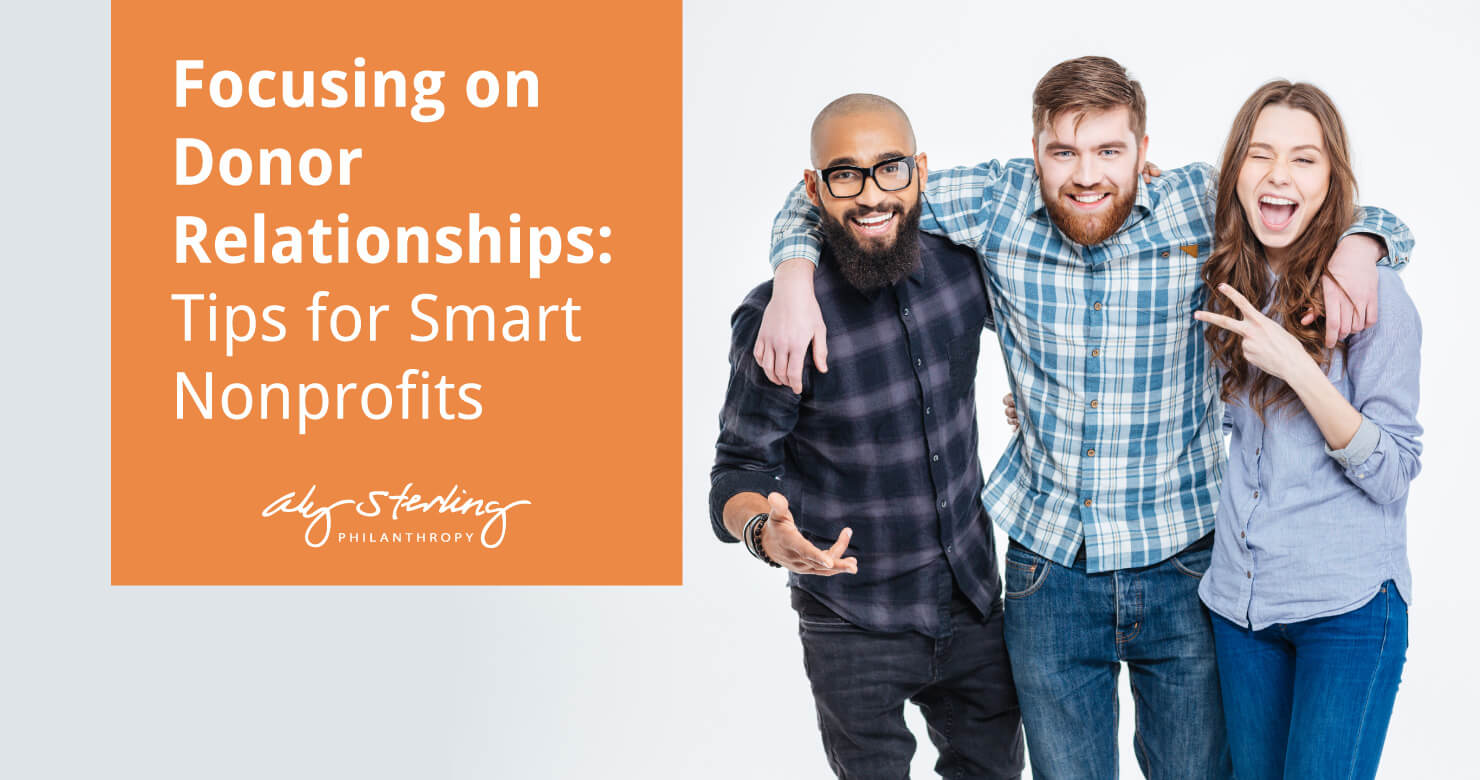
Relationships are an essential part of being human. They strengthen our emotional well-being and are a main motivator for decision-making. Because nonprofits need dedication and commitment from donors to drive donations and power their missions, developing relationships is key for the entire industry.
According to Bloomerang’s donor management guide, it’s vital to optimize every stage of the donor journey, from when supporters first become aware of your organization to when they decide to donate and continue supporting you. Doing so will help you build genuine relationships and avoid letting any donors fall through the cracks.
While there are many ways to build relationships with supporters, we find that the following four strategies have the greatest impact:
- Segment your donors.
- Go above and beyond to show appreciation.
- Highlight donation impact.
- Steward supporters before your next ask.
This guide will explore these four tips to improve your donor engagement strategy, boost retention, and maximize fundraising success.
1. Segment your donors.
Personalized outreach is essential for ensuring your content stands out from other marketing messages donors receive. When you reach out to a supporter with a message that appeals to their specific interests, they’ll be much more likely to pay attention and respond positively.
However, personalizing every donor email or letter takes a lot of work. New organizations with a smaller supporter base may be able to manage this, but it’s not sustainable for larger or growing nonprofits.
Segmenting supporters using your nonprofit’s donor management system is the best way to reach out with personalized messages efficiently.
Use donor data to group your supporters by shared characteristics. For example, you can group donors based on giving habits, such as:
- Recency: How long have donors been giving?
- Frequency: How often do donors give?
- Type: What kinds of gifts do donors contribute?
- Amount: How much are donors giving?
- Reason: Why do donors give?
- Interest: What aspects of your mission are donors most interested in?
Depending on your outreach goals, you could also segment donors based on other criteria, such as age, geographic location, or which of your programs they are interested in.
After creating your segments, you’re ready to reach out to supporters personally and efficiently. Each segment you create will require a slightly different communication pathway to keep donors engaged and informed based on their interests and needs. For example, you’ll probably send educational materials to first-time donors to tell them more about your mission and programs. Long-time donors, however, won’t need this information but would appreciate impact updates about the positive effects of their donations.
2. Go above and beyond to appreciation.
It’s polite to show appreciation for your supporters. But genuine and frequent thank-you messages also help build strong connections with donors.
We recommend going above and beyond a simple confirmation email to ensure your gratitude messages stand out. Take additional steps to show supporters that you care about their involvement, such as:
- Sending handwritten thank-you letters
- Calling your donors to express gratitude
- Mailing donors free merchandise branded to your nonprofit, like stickers, water bottles, or tote bags
- Providing campaign follow-up emails with progress updates
- Inviting donors to exclusive events, such as networking opportunities
Use the data stored in your donor database to personalize outreach messages with donors’ names and references to past interactions, like their recent donations.
Here’s an example of a handwritten thank you message you could send to a recent donor:
Dear Angela,
Thank you so much for your recent gift of $100 on December 3rd. Attached is a photo of our volunteers at a recent beach cleanup. Your generous gift equipped volunteers with the supplies they needed to collect 800 pounds of trash. We wouldn’t be able to keep our community’s recreation areas clean without your tireless support!
Planning special moments and tailored interactions will make your appreciation messages more memorable and meaningful for donors.
3. Highlight donation impact.
To transform one-time gifts into long-term loyalty and support, show donors that you’re following through with your promise to use their gifts for mission-critical activities. By demonstrating the impact of donor gifts, you’ll reassure them that they made a smart investment.
Here are some examples of how you can demonstrate the impact of giving at different levels:
- A major donor provides a substantial donation that helps fund the initial expenses for a brand-new program. You decide to meet with them in person to discuss the program’s projected outcomes and let them know that you were able to purchase all necessary supplies with the help of their generous donation. You might take this further by highlighting that major donor in your annual report when celebrating what the new program has accomplished or adding them to your donor wall.
- A mid-tier donor contributes ongoing monthly contributions. Your fundraising team decides to develop personalized impact reports for mid-tier donors that showcase the impact of their consistent support. Each report includes visuals, such as charts and graphs showing the growth of donors’ support over time and how their gifts build on each other to help more community members in need.
- Lower-tier donors provide small donations that add up to reach your online fundraising campaign goal. Instead of telling supporters exactly what each small donation did, you can send messages saying, “Your generous contribution of $10 helped provide meals to elementary school students in your community. This year’s campaign provided 1,510 meals in total!”
Providing impact updates for donors at every level shows supporters that you appreciate every gift, regardless of size. Plus, they’ll understand the tangible impact that their donation is making, creating a positive association that may encourage them to donate again.
4. Steward supporters before your next ask.
If you ask for donations too often from your supporters, they’ll start to feel like an ATM. That’s why your nonprofit should steward donors by offering them other ways to engage, showing your appreciation, and strategically asking for another gift. This cyclical process will lead to reliable and sustainable long-term fundraising success.
Let’s look more closely at these critical donor stewardship activities to incorporate into your donor management processes:
Steward supporters between donation requests
After donors give, it’s helpful to highlight other ways they can get involved with your nonprofit to strengthen their ties to your cause. Steward your supporters and offer a variety of engagement opportunities by:
- Inviting supporters to exclusive events
- Encouraging supporters to follow you on social media
- Inviting donors to join your volunteer program
- Asking donors to participate in advocacy campaigns
- Sending surveys to supporters asking about their experience with your nonprofit
Stewarding donors is all about strengthening the connection between your supporters and your organization. It encourages them to read, learn, network, and get involved in ways other than donating. When done properly, donor stewardship shows you care about their input and opinions, not just their money. Use these tips in conjunction with the donor appreciation efforts described earlier in the post to make a strong, positive impression.
Ask for additional gifts strategically
After conducting stewardship activities, it will be time to ask donors for another gift. Ideally, you’ll have kept contact with donors through email newsletters, texts, and social media posts, so donors understand the value of their gifts.
To maintain a positive relationship, ask for additional donations strategically and thoughtfully. Follow these tips to make the most of your asks:
- Choose a specific gift amount to request. Conduct prospect research for major and mid-tier donors to determine a gift amount that will be manageable for the donor and useful for your nonprofit. If they aren’t receptive to your initial request, be flexible and drop to a lower donation request.
- Offer suggested donations for online donors. Suggested donation amounts make it easier for donors to choose how much they want to contribute. On your donation pages, provide suggested giving amounts that slightly exceed your organization’s average donation. For instance, if the average gift you receive is $20, offer giving buttons for $25, $50, and $100. Those who would usually give $20 will likely bump their gift up to $25 as it’s the closest to their original intended gift.
- Check for corporate philanthropy eligibility. Corporate philanthropy involves companies financially supporting philanthropic initiatives, often those that their employees contribute to. Donors will be excited to learn their gifts can have an even greater impact through corporate philanthropy opportunities like matching gifts and volunteer grants.
- Invite donors to join your legacy or planned giving program. Major donors often have the necessary giving capacity to contribute a planned or legacy gift as part of their wills. Identify planned giving prospects from within your major donor pool. These supporters tend to be older (around 45-65 years old), with a robust history of past donations to your organization. Highlight the benefits of joining your planned giving program, such as the opportunity to leave a positive impact on a cause that’s close to their hearts.
Track supporters’ engagement with each giving option to identify their giving preferences and make a note to follow up in the future with similar opportunities. By tailoring your asks to each donor’s preferences, you can increase the likelihood that supporters will decide to continue giving.
Building donor relationships is vital to strategic fundraising. Impactful two-way relationships allow your organization to raise more throughout the year and retain your supporters for the long term. Use our tips to start developing personal relationships with your donor community and watch your fundraising reach new heights.
Co-Founder and current Chief Relationship Officer at Bloomerang
Jay has served this sector for 33 years and is considered the most well-known senior statesman whose advice is sought constantly.
Prior to Bloomerang, he was the CEO and Co-Founder of eTapestry for 11 years, which at the time was the leading SaaS technology company serving the charity sector. Jay and his team grew the company to more than 10,000 nonprofit clients, charting a decade of record growth.
He is a graduate of Butler University with a B.S. in Business Administration. Over the years, he has given more than 2,500 speeches around the world for the charity sector and is often the voice of new technology for fundraisers.
